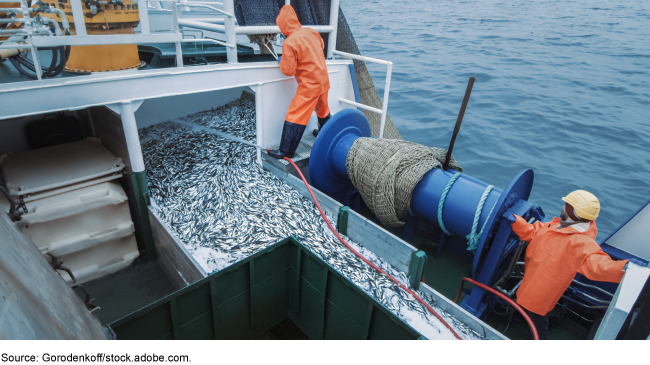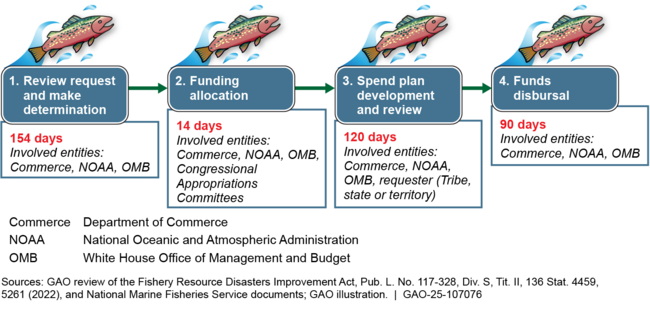Fishery Disaster Assistance: Process is Changing, but Challenges Remain to Improve Timeliness and Communication [Reissued with revisions on Jun. 25, 2025]
Fast Facts
Disasters like hurricanes and oil spills can affect fisheries and communities and may result in lost revenue or jobs. When a fishery disaster occurs, eligible entities such as states or Tribes may request assistance from the National Marine Fisheries Service.
We found the agency generally took 3 years to disburse funds for some of the 111 requests it received since 2014. The agency is altering the program in an effort to reduce the process to 1 year.
Tribal and state officials told us the agency's website needs more information about the assistance process and its requirements.
Our recommendations address this issue and more.

Reissued on June 25, 2025, to correct information in the sidebar on page 22 on the Snow Crab Disaster.
Highlights
What GAO Found
The Department of Commerce's National Marine Fisheries Service (NMFS) is responsible for administering the fishery resource disaster program. The process to provide assistance and disburse funds involves several phases. Since January 2014, NMFS received 111 fishery disaster requests. For 56 of the most recently approved requests, NMFS took between 1.3 years and 4.8 years to disburse $642 million. Changes made by 2022 legislation added timelines to the steps; if followed and funding is available, the process should take a little over a year.
Process to Provide Fishery Resource Disaster Assistance

Stakeholders cited program challenges like long processing times for requests and inadequate communication about request status. NMFS started to implement the timelines created by the 2022 legislation and use a new data system to track requests. But access to this system is limited. Granting access to NMFS officials working on the program could help them respond to questions about request status. Tribal and state officials told GAO they would like more detailed information on the process, including what to include in requests and spend plans. Providing more detailed information on its website would better inform requesters about the information they need to submit. NMFS' workload has increased to implement the statutory timelines added in 2022, but NMFS has not assessed staffing levels for the program. Assessing staffing capacity would help NMFS ensure it has sufficient staffing to administer the program.
Some stakeholders said the fishery resource disaster program could learn from other federal programs. GAO reviewed its past work on four disaster-related assistance programs with various design features identified and programmatic challenges compared with the fishery program. Design features included eligible uses of assistance and source of program funding. For example, under the federal crop insurance program, farmers receive financial protection against losses. However, the federal government heavily subsidizes this program and its high cost is a challenge. GAO has made suggestions to Congress to address the program's costs, but they have not been implemented.
Why GAO Did This Study
Marine fisheries are critical to the nation's economy, generating $321 billion in production sales and supporting approximately 2.3 million jobs in 2022. The number of fish caught and revenue generated can be subject to disasters, such as hurricanes or oil spills. When a disaster occurs, an eligible entity—such as a Tribe, state, or territory—may request federal assistance from the fishery resource disaster program to help fishers and the community recover.
GAO was asked to review various aspects of this program. This report addresses, (1) the process to provide assistance; (2) the number of disaster requests from January 2014 through June 2024; (3) challenges with the program; and (4) GAO's past work on selected disaster-related assistance programs and how they compare.
GAO reviewed relevant laws, NMFS policies and documents, and NMFS data on fishery resource disaster requests submitted from January 1, 2014, to June 30, 2024. GAO interviewed NMFS officials and stakeholders from 10 states, five tribes, and 11 fishing industry groups and others, selected because of their experience with the program and to reflect different regions. GAO also conducted site visits to Alaska and Louisiana.
Reissued with revisions on Jun. 25, 2025
Reissued on June 25, 2025, to correct information in the sidebar on page 22 on the Snow Crab Disaster.Recommendations
GAO is making three recommendations, including that NMFS provide more detailed information to stakeholders about the fishery resource disaster process and assess if staffing capacity is sufficient to administer the program. NMFS agreed with our recommendations.
Recommendations for Executive Action
| Agency Affected | Recommendation | Status |
|---|---|---|
| National Marine Fisheries Service | The Assistant Administrator for NMFS should provide access to the tracking system to staff working on the fishery resource disaster program and use information from this system to update the program website. (Recommendation 1) |
When we confirm what actions the agency has taken in response to this recommendation, we will provide updated information.
|
| National Marine Fisheries Service | The Assistant Administrator for NMFS should provide more detailed information on NMFS' website about the fishery resource disaster process to clarify the requirements for documents submitted by requesters, such as requests for fishery resource disaster assistance and spend plans. (Recommendation 2) |
When we confirm what actions the agency has taken in response to this recommendation, we will provide updated information.
|
| National Marine Fisheries Service | The Assistant Administrator for NMFS should assess whether staffing capacity is sufficient to administer the fishery resource disaster program. (Recommendation 3) |
When we confirm what actions the agency has taken in response to this recommendation, we will provide updated information.
|
